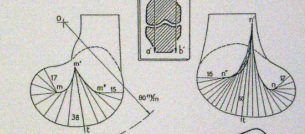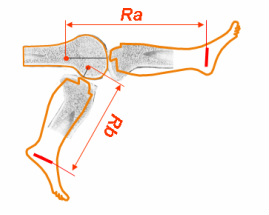the center of the knee
From the analysis of the roto-translational dynamic as reported above, we deduce that in the flexion-extension mechanics, the knee does not perform a pure rotary motion pivoted on a single fixed center, but these moves in function of the degree of flexion reached. By the maximum extension of 25 degrees of flexion the center of rotation remains positioned in a fixed point (initial center of rotation); after the 25-30 degrees of flexion the instantaneous center of rotation tends to move in an increasingly important way towards the articular surfaces (istantaneous center of rotation).
We can ,therefore, hypothesize that the variation of the center of rotation causes a change in knee-malleolus length. In fact, the distance between the initial center of rotation and an anthropometric point located on the malleolus of the leg (Ra) is greater than the distance between the instantaneous center of rotation located at the maximum flection and the same point malleolar (Rb).
The difference Ra - Rb is ΔR.
Consequently if the knee is made integral to a mechanical device that rotates around a fixed center, the difference between the path of the knee and that of the mechanical device, produces a distancing between the articular heads because the mechanical system is "stronger" than the organic one and drags the articular heads on its own trajectory that does not change its amplitude.
Consequently if the knee is made integral to a mechanical device that rotates around a fixed center, the difference between the path of the knee and that of the mechanical device, produces a distancing between the articular heads because the mechanical system is "stronger" than the organic one and drags the articular heads on its own trajectory that does not change its amplitude.


